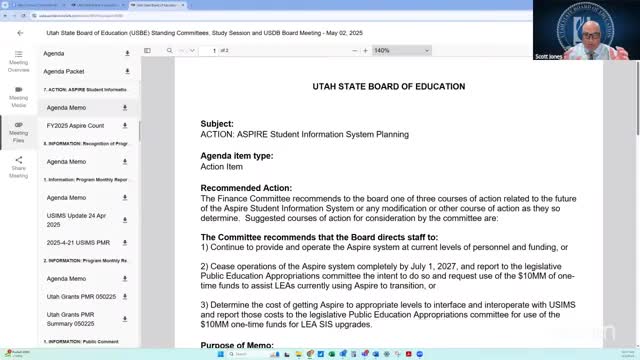Education Board weighs future of Aspire system amid funding and competition concerns
May 02, 2025 | Financial Operations , Utah Board of Education, Offices, Departments, and Divisions, Organizations, Utah Executive Branch, Utah
Thanks to Excel Chiropractic and Scribe from Workplace AI , all articles about Utah are free for you to enjoy throughout 2025!

This article was created by AI using a video recording of the meeting. It summarizes the key points discussed, but for full details and context, please refer to the video of the full meeting. Link to Full Meeting
One of the primary concerns raised was the need for Aspire to meet evolving educational standards and interoperability requirements. Currently, Aspire serves a significant number of LEAs, but only accounts for about 12% of the total student population. The committee is considering three main courses of action: maintaining the current system with existing staffing, ceasing operations of Aspire by mid-2027, or upgrading Aspire to meet necessary standards.
The discussions revealed a slight increase in Aspire's user base, attributed to cost-saving measures by charter schools switching from other systems. However, the committee acknowledged that maintaining the current level of service with only six full-time employees (FTEs) may not be sustainable in the long term. The need for additional staffing and resources was emphasized, as current personnel are stretched thin managing the demands of the existing system.
Board members expressed concerns about the financial implications for LEAs if Aspire were to be discontinued. Many smaller districts rely heavily on the system, and transitioning to alternative vendors could impose significant costs. The committee is tasked with determining the costs associated with upgrading Aspire to meet modern standards and the potential financial burden on LEAs should they need to seek funding for alternative systems.
In conclusion, the Finance Committee's discussions underscore the importance of making informed decisions regarding the future of Aspire. The outcomes of these deliberations will not only affect the operational capabilities of the system but also the financial stability of the LEAs that depend on it. The committee plans to reconvene next month to further explore these options and their implications for Utah's educational landscape.
Converted from 20250502 May 2, 2025 Finance Committee (Live) meeting on May 02, 2025
Link to Full Meeting
Comments
View full meeting
This article is based on a recent meeting—watch the full video and explore the complete transcript for deeper insights into the discussion.
View full meeting
